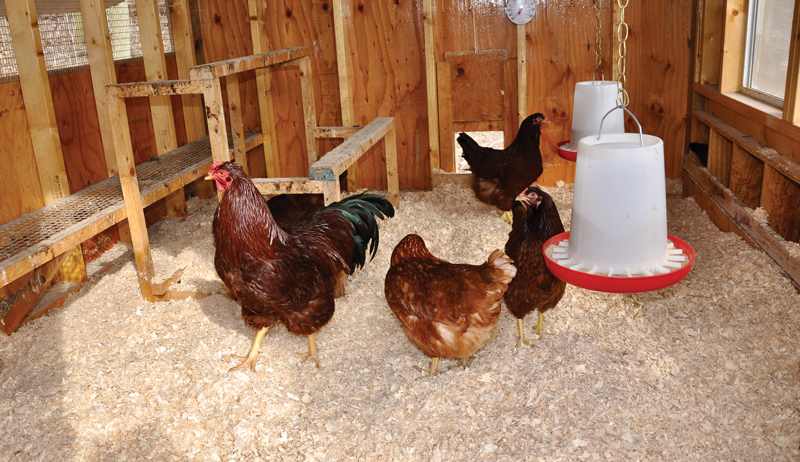Raising backyard chickens is becoming an increasingly popular hobby. Chicken owners enjoy having a readily available supply of fresh eggs as well as fun animal companions. However, keeping chickens healthy and happy requires proper housing setups, including choosing the right type of chicken coop bedding.
What is Deep Litter Bedding?
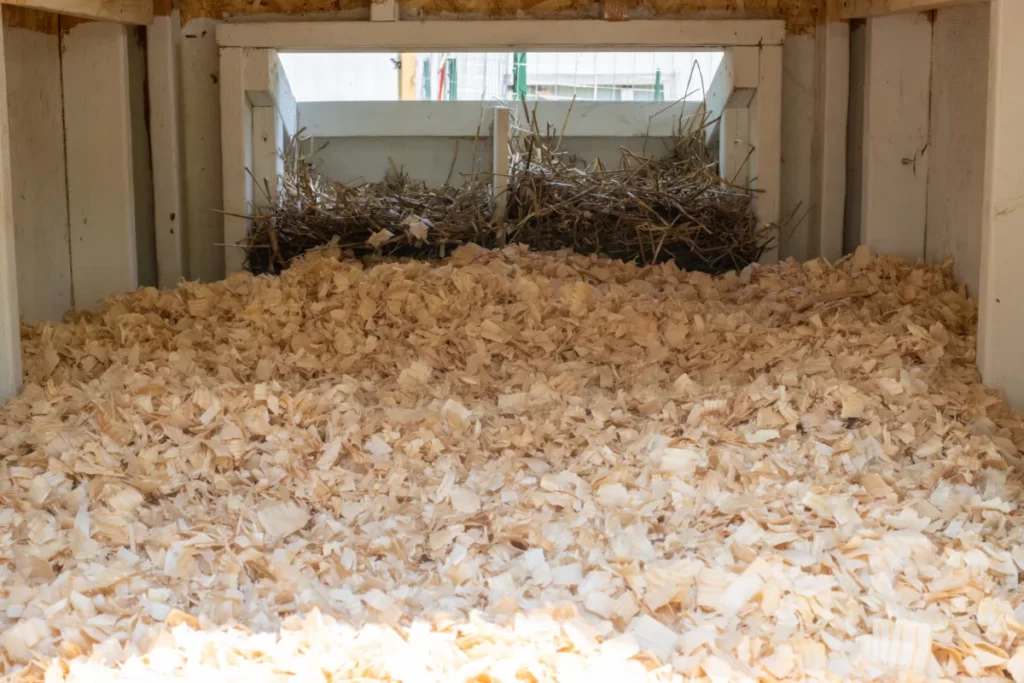
Deep litter bedding, also known as deep litter method or deep bedding, refers to a bedding system for chicken coops that involves building up a thick, absorbent layer of bedding material over an extended period of time. As the chickens walk, scratch and peck in the coop, their manure and nitrogenous wastes accumulate and decompose within this bedding layer.
The deep litter technique takes advantage of the natural composting ability of carbon-rich organic materials like wood shavings, straw, shredded newspaper or pine needles. Over time, aerobic bacteria, fungi and actinomycetes colonize the bedding and break down the manure and litter into compost under the chicken’s feet. This creates a natural biofilter that keeps odors, flies and parasites in check.
The bedding develops into a dry, loosely packed layer that continues decomposing and releasing beneficial heat to keep chickens comfortable year-round. As the bedding layer builds up, chicken owners simply add fresh litter to maintain a depth around 6 inches (15 cm). The deep litter only needs changing every 6-12 months.
Benefits of Using Deep Litter Bedding
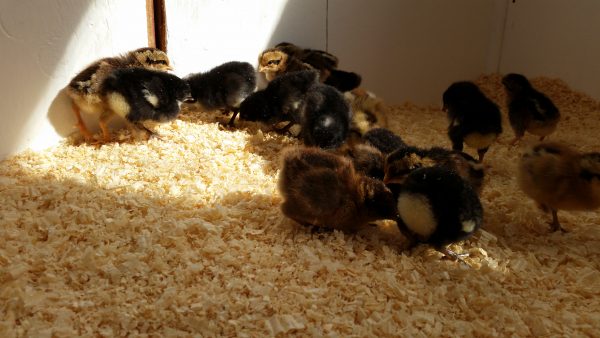
Switching to a deep litter system offers chicken keepers several advantages over traditional coop beddings that require frequent changing, such as sand or wood shavings.
1. Low Maintenance
Deep litter bedding is extremely low maintenance and easy to manage. Since it does not require changing out very often, it saves chicken owners major time and labor compared to bare floors or beddings like sand that allow manure to accumulate quickly. The composting action of the deep litter helps control moisture and prevents it from becoming excessively dirty or developing harmful fungal blooms.
2. Natural Biofilter & Healthier Environment
The deep litter bedding acts as a living biofilter in the chicken coop environment. Beneficial microbes thrive in the litter and work hard to break down droppings and other inputs, suppressing pathogens. This leads to significantly lower levels of harmful germs like E. coli, coccidia protozoa and fungi that cause respiratory illness.
With fewer flies buzzing around, chickens also experience less external parasite pressure from pests like mites, fleas and lice. The balanced population of microorganisms keeps chickens exposed to diverse microbiota, supporting stronger immune systems.
3. Insulation & Temperature Regulation
As the litter composts, chemical and microbiological processes release heat to warm the coop floor. This heat radiates up through the bedding, warming chicken’s feet and bodies. On cold nights, the slight but stable boost in temperature helps keep chickens comfortable.
The loose, fluffy texture of materials like pine shavings also traps air to prevent heat loss through the floor. In summer, the bedding keeps cool underground to give chickens a reprieve from hot days. Avoiding major temperature fluctuations is key to keeping chickens healthy.
4. Ammonia & Odor Control
In a properly managed deep litter system, populations of beneficial bacteria digest nitrogenous wastes and convert ammonia into inert nitrogen gas instead of noxious fumes. Actinomycete fungi also break down odorous sulfur compounds.
This biological filtration results in remarkably low odor levels. Chicken owners notice hardly any bothersome smells emanating from the coop, even with months of accumulated litter. Visitors are often surprised at how clean the coop smells.
5. Cushioned Floor Prevents Injuries
Several inches of loose, fibrous litter cushion a chicken’s fall if they fly down from a roosting bar or take a bad step. Chickens naturally love scratching and foraging through the soft litter too. This protects delicate feet, legs and keels from bruises or breaks that can happen on bare floors. Elderly chickens prone to bone weakness especially appreciate the gentle walkability.
6. Encourages Natural Foraging Behavior
The varying textures and densities within the deep litter bedding system provide endless opportunities for curious chickens to dig, scratch and peck. Chickens spend up to 80 percent of their active time foraging. Having outlets to express these innate behaviors keeps chickens happier and less stressed. Pecking through litter and fallen treats also encourages more exercise.
7. Fertilizer for Gardens
The nutritious compost that forms in deep chicken litter makes an excellent organic fertilizer. Chicken owners can remove and spread batches of spent litter to condition soil for raised garden beds or landscaping. The balanced nutrient profile with beneficial microbes nourishes plants quickly.
8. Reduced Waste & Environmental Impact
Because deep litter lasts so long without changing, it produces far less waste material than other bedding types. This greatly reduces plastic waste from wood shaving bags. With more nutrients and organics kept cycling on-site instead of hauling to the landfill, it also has minimal environmental impact. Home composting the spent litter later maximizes sustainability.
Choosing Litter Materials for Deep Bedding
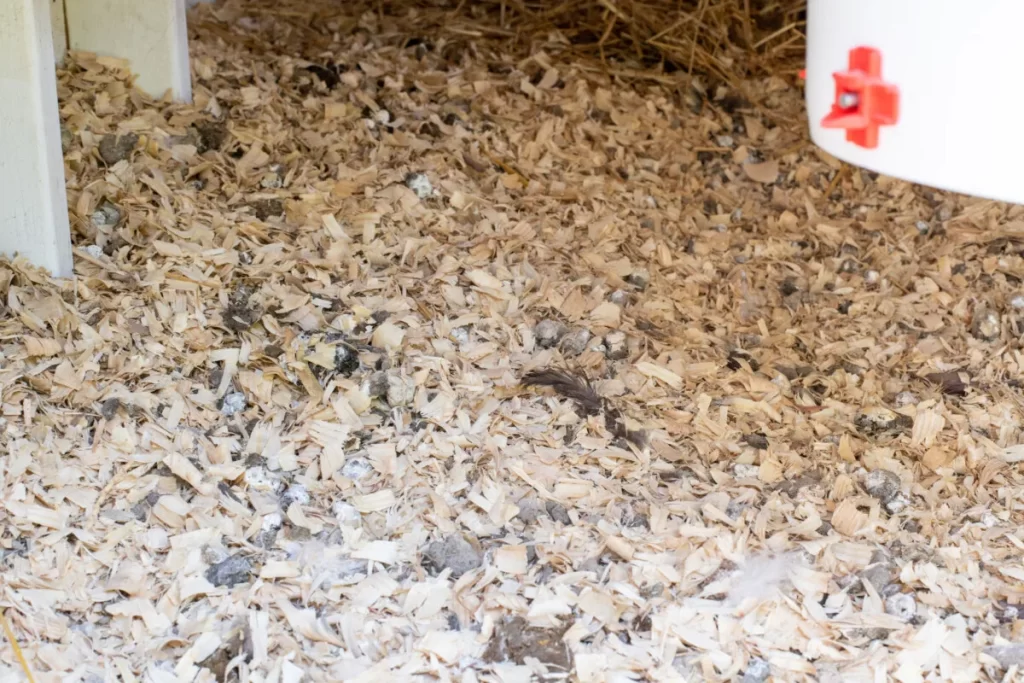
While the deep litter method works similarly across various basic materials, some make better choices than others depending on climate conditions, budget and specific goals. Consider the attributes of each bedding type before deciding which is right for your coop.
Wood Shavings
Wood shavings, typically from pine or other softwoods, are the most popular choice among chicken owners. Their fine, fluffy texture provides excellent moisture absorption, light insulation and aerated conditions for composting. Wood shavings are readily available at farm supply stores and in bulk deliveries for large coops, keeping costs reasonable.
Avoid cedar shavings, however, as the aromatic oils naturally present in cedar can be potent and irritate chicken’s sensitive respiratory systems. Stick to kiln-dried pine for healthiest flocks. Spruce or aspen shavings work as well.
Chopped Straw
For chicken keepers with access to inexpensive or free straw, using chopped straw for litter merits consideration. Long-stemmed straw should be run through a chopper/shredder first to make pieces small enough that they will not irritate chickens if eaten. Wheat, oat, barley and rice straw all work well for litter.
Like wood shavings, straw provides an outstanding medium for composting manure while staying loose and promoting drying. The hollow stems trap more warm air to amplify heating through decomposition. This makes straw an excellent cold-weather bedding. Straw does tend to allow more dust and particles into the air though, which may irritate some chicken’s lungs. Avoid straw that contains herbicide residues.
Sand
While sand makes a poor standalone litter choice since it compacts readily and allows moisture buildup, adding a 20 percent portion of construction sand or natural sand into wood shavings or straw litter provides extra grit. Chickens ingest tiny pebbles both for digestive health and access to trace minerals. Sprinkle thin layers of sand occasionally atop the litter to supplement their diet.
Peat Moss
Peat moss offers similar absorbency and composting dynamics to wood shavings, with the added advantage of native microbiota beneficial to live plant roots. This makes peat moss litter ideal for greenhouse-style coops that aim to recycle chicken manure for fertilizing gardens under the same structure. The downside is that peat moss is still produced through unsustainable harvesting practices in sensitive wetland ecosystems. Use sparingly.
Leaves
Dry leaves from deciduous trees (especially oak leaves) present an abundant free material for making leaf litter. Leaf litter takes longer to start composting effectively, but using leaves is a great way to prevent them from filling landfills unnecessarily. Chop or shred leaves to speed decomposition. Avoid leaves from plants toxic to chickens like black walnut trees.
Newsprint or Cardboard
Many chicken owners include shredded newspaper or cardboard into their deep litter to provide more carbon and support drying. Non-glossy newspaper inks these days are soy-based instead of lead-based too. Tear up pieces small enough that chickens will not eat them and create compostable scraps. Avoid using glossy magazines or cardboard shipping boxes with dyes, however, as these can leach harmful chemicals.
Chicken Manure Compost
This one may sound strange, but pre-composted chicken manure from another compost pile actually makes an outstanding litter amendment blended with wood shavings or straw. The stabilized organic matter introduces key soil microbes right from the start to accelerate in situ composting. Screw press separated manure solids also work wonderfully to amplify digestive efficiency of the deep litter system.
Preparing a Coop for Deep Litter Bedding
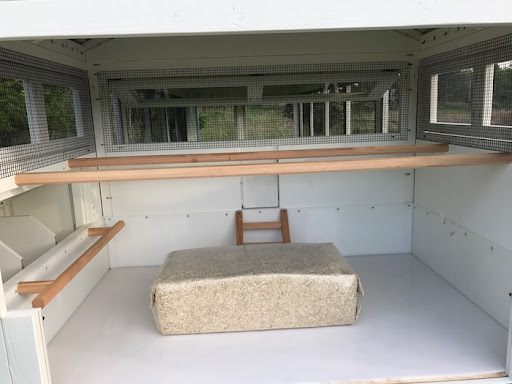
Setting up the floor and layout of a chicken coop properly makes maintaining the deep litter method much simpler. Here are best practices to follow:
1. Choose a Dry, Well-Drained Site
Select a naturally dry building site or grade the land to encourage drainage away from the coop in all directions before laying the foundation. While the deep litter itself can handle some moisture, excessively wet underlying soil often causes failure. Create a base layer with gravel, sand or patio paver stones to prevent floods or moisture wicking up from below.
2. Install a Dirt Floor
A solid earthen floor allows the litter system to interact with live soil ecology. Nutrients and microbes cycle through more dynamically to the bedding. Temperatures also moderate better through contact with the ground. Level any bumps or divots to help keep litter depths even.
3. Apply a Moisture Barrier
To protect dirt floors from becoming waterlogged if drainage outside fails, roll out sheets of woven landscape fabric before pouring any bedding. Choose breathable, porous cloth that still blocks moisture, not solid polyethylene plastic. Excess moisture should trickle under the cloth to the exterior soil.
4. Add Ample Ventilation
The aerobic composting capacity of deep litter depends on plenty of fresh airflow. Install windows, eave vents, cupolas and pop-doors to encourage excellent cross ventilation. Place extra vents near the floor so that incoming air constantly cycles up through the litter itself, drying it from underneath.
5. Augment Natural Light
Bright lighting allows chickens to sustain active foraging and makes it easier for owners to monitor litter conditions. Position roosting bars and dust bathing boxes to catch morning light through windows or doors so those areas stay dry. Add LED light bulbs if coop layout cannot leverage enough ambient daylight.
6. Wide Doors for Litter Transport
To simplify maintenance down the road, install exterior human doors around 3 feet (1 meter) wide to easily fit a wheelbarrow. The wide doors give clean access bringing fresh bedding in and ferrying spent litter to the compost pile or garden. Locate doors near corners so entire floor area stays accessible.
Maintaining the Deep Litter System

Caring for deep litter does not take much labor once up and running, but chicken owners should adopt certain routines for best results. Monitor these aspects of litter function:
1. Check Litter Temperature
Plunge a compost thermometer down into the litter in several spots to check if interior temperature stays between 90-100 ̊F (32-38 ̊C). This indicates balanced microbial action. If certain areas spike much warmer, redistribute litter to cool it down. Let it rest outside the coop for a day if removing excess heat.
2. Watch for Compaction
Deep litter should remain loose and flocculated, with fine air pockets between particle aggregates. If areas show signs of compaction where gases and moisture cannot flow, use a pitchfork to gently turn and fluff the material. Add extra bulking agent like wood chips if necessary.
3. Supplement Carbon Regularly
To maintain porosity and support the decomposition process, sprinkle or rake thin layers of additional high-carbon bedding like leaves, straw or paper weekly. Target the cardboard to areas soiled the most. This keeps the C:N ratio optimized for compost biology.
4. Reduce Nitrogen Overloads
If certain zones appear darkened, excessively damp or start emitting foul odors of anaerobic decay, remove the nitrogen-heavy patches. Scoop soiled litter into compost piles or a worm bin to balance it with more carbon sources there. Refill the coop litter to recommended depths with fresh material.
5. Cultivate Beneficial Microbes
To amplify the probiotic advantages of deep litter, buy or culture batches of bacillus bacteria, white button mushrooms, black soldier fly larvae, red wiggler worms or other proven composting organisms. Then sprinkle these over and mix within litter to inoculate it with diverse beneficial species.
6. Screen for Pests
Check deep litter routinely for signs of pests like rats or snakes that may attempt to nest in the protected environment. Set humane traps around the exterior if evidence emerges. The biofilter normally prevents fly issues, but always watch for larvae just in case populations spike and need managing with beneficial nematodes or diatomaceous earth to cut numbers.
7. Rake Smooth Before Adding Litter
Each time clean bedding gets added to bolster depths, first rake, hoe or turn over the current surface using a round point shovel to distribute fresh pockets through the layer cake of organic matter. Top with 2-4 inches (5-10 cm) of new litter afterward, keeping total depths around 6 inches (15 cm).
When to Empty Out & Replace Litter
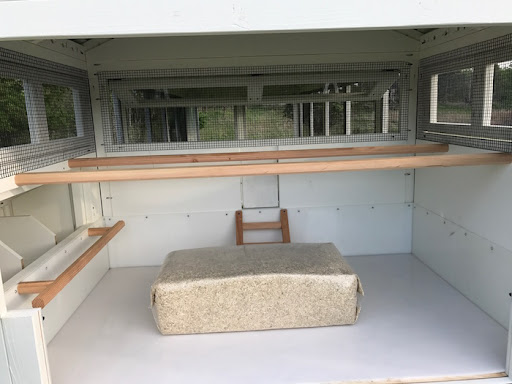
The real beauty of the deep litter system comes from not needing frequent litter changes. Yet at a certain point as the bedding ages, it’s odor-controlling and insulating capacity drops off. Signs it is time for a refresh:
- Ammonia smells increase
- Surface seems muddy or wet
- Bottoms of litter compact into sludge
- Chickens start avoiding certain areas
- Litter exceeds 12 inches (30 cm) depth
- Significant pest issues arise
- Annual cleanout for disease prevention
During coop cleaning, take the opportunity to repair any damaged flooring, seal small holes that allow rats or snakes to enter and address ventilation problems. Then start fresh!
The removed litter often finishes composting rapidly when mixed with higher nitrogen inputs like green grass clippings. After a month or two, valued fertilizer emerges ready for gardens and landscape plants. Or let worms in a vermicomposting bin rapidly transform it all into vermicompost for seed starting mixes.
Conclusion
Deep litter bedding offers chicken keepers a natural, low-maintenance solution for housing backyard flocks comfortably while supporting their health through microbiome balancing. By leveraging the innate composting ability of carbon-rich organic substrates, owners can save hugely on time and labor expenses compared with intensive litter management tactics. Done properly, the system reliably breaks down manure and nitrogenous wastes while producing warmth, optimizing humidity and preventing pests and parasites. Paying attention to proper moisture levels, microbial activity and adding small doses of fresh bulking agents is all it takes to perpetuate rich, living litter chickens will love stomping around in. The bonus fertility resources produced provide sustainability benefits as well. Going deep with litter lets small-scale poultry farmers enjoy the perks of raising chickens, without all the usual hassles.


